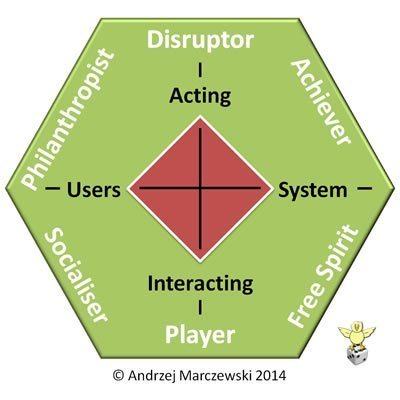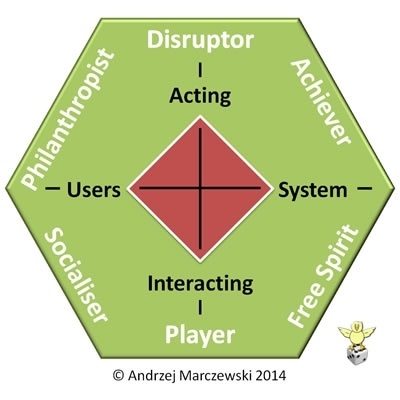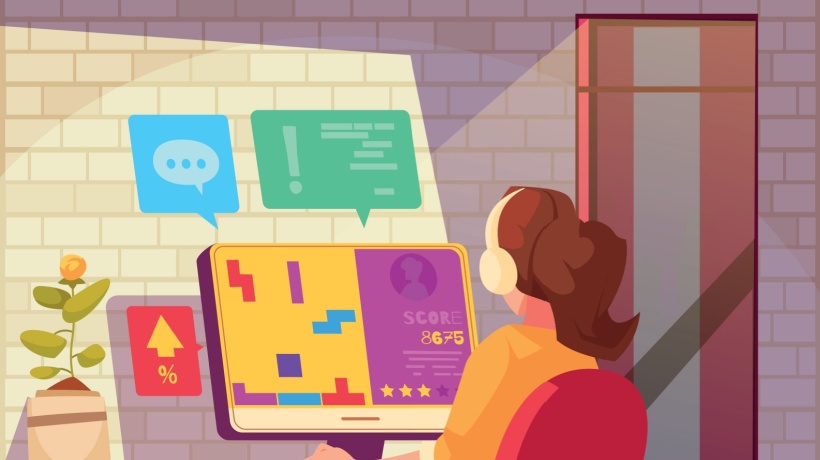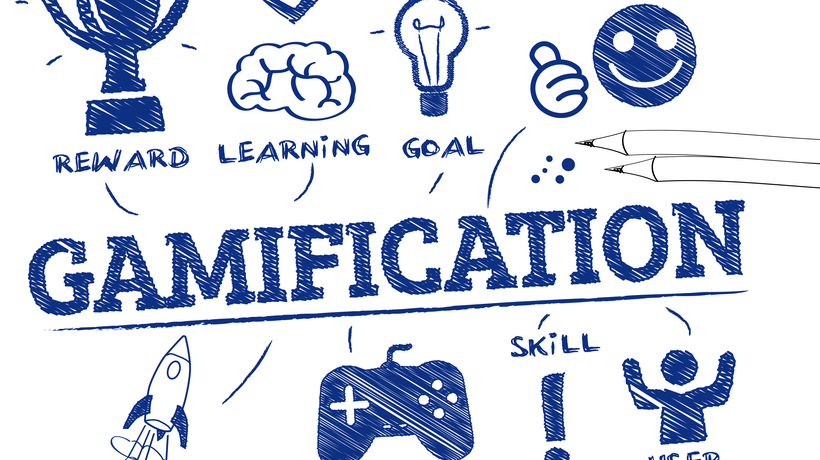Marczewski’s Gamification User Types: a taxonomy for users in gamified systems.
Whilst it is possible to design games, serious games or gamified systems without understanding who the target players and users are, you are more likely to create a more engaging experience if you spend some time getting a feel for them.
Bartle’s Player Types
In the gaming world there are a few taxonomies and models to describe player behaviour and types. Nicolle Lazaro’s 4Keys2Fun (1), Nick Yee’s Model of Player Motivations (2) and Amy Jo Kim’s Social Player Types (3) to name a few. However, the most famous is probably Bartle’s Four Player Types (4). Whilst there is also an eight type model, this is far less frequently mentioned.
In early 1990, after discussions with users of his Multi User Dungeon (MUD) game, Dr Richard Bartle proposed a model of the types of player they had observed. The model had four basic types and described how they interacted with each other and affected the game in general. For four types were, Killer, Achiever, Socialiser and Explorer. Each one behaved in a distinct way within the MUD and either acted or interacted with people or the game world.
Later he would expand this to eight types and also described how users evolved over time (5).However, as Dr Bartle himself explains, his user types are great for MUDs or Massively Multiplayer Online RPGs (MMOs), but they don’t map well to other games or other types of system – including gamified systems.
Marczewski’s Gamification User Types
As such, I wanted to look at a more gamification specific taxonomy for types of users within systems.Starting from the perspective of intrinsic motivation, I chose to use ideas from Edward Deci and Richard Ryan’s Self Determination Theory (6) and Daniel Pinks Drive (7). Self determination theory describes three intrinsic motivations; Autonomy, Competency and Relatedness. Drive talks about Autonomy, Mastery and Purpose. Combining these, I settled on four motivations. Relatedness, Autonomy, Master and Purpose.From these, four types of intrinsically motivated user types were described. Socialiser, Free Spirit, Achiever and Philanthropist.As well as these four types, a fifth type was suggested; an extrinsically motivated type, Player. Finally and much later on a sixth type was included, the Disruptor. (8)
In brief, these types behave as follows
- Socialisers are motivated by Relatedness. They want to interact with others and create social connections.
- Free Spirits are motivated by Autonomy. They want to create and explore.
- Achievers are motivated by Mastery. They are looking to learn new things and improve themselves. They want challenges to overcome.
- Philanthropists are motivated by Purpose and Meaning. This group are altruistic, wanting to give to other people and enrich the lives of others in some way with no expectation of reward.
- Players are motivated by Rewards. They will do what is needed of them to collect rewards from a system. They are in it for themselves.
- Disruptors are motivated by Change. In general they want to disrupt your system, either directly or through other users to force positive or negative change.

The point of the Gamification User Types was to give people a better understanding of why and how people would use a system and how you could better engage with them. It also helps to demonstrate that people are all different and that there is no one size fits all approach.
Gamification User Type Test
I created the Gamification User Type Test as way of capturing people’s user types, to get a better understanding of the balance you will find in gamified systems. The test can be used in two ways.
- The first is to use the collected data that already exists to make decisions on what user types are most important to design for. This would help you with a more generic approach.
- The second would be to use the test with a target set of users and use that data to design a more focused experience for them.
However people choose to use it, my hope is that the data collected can improve the way people design gamified systems and how they approach gamification in general.If you would like to help me out by taking the Gamification User Type test, please head to http://marczewski.me.uk/UserTypeTest/user-type-test.php and have a go. The more data I collect, the more accurate the model can become!
References
Works Cited
- Lazzaro, Nicole. The 4 Keys 2 Fun. [Online] http://www.nicolelazzaro.com/the4-keys-to-fun/.
- Yee, Nick. Nick Yee. [Online] http://www.nickyee.com/daedalus/archives/001298.php.
- Kim, Amy Jo. Amy Jo Kim. [Online] http://amyjokim.com/2012/09/19/social-engagement-whos-playing-how-do-they-like-to-engage/.
- Bartle, Richard. HEARTS, CLUBS, DIAMONDS, SPADES: PLAYERS WHO SUIT MUDS. Multi User Entertainment LTD. [Online] http://www.mud.co.uk/richard/hcds.htm#1.
- —. Designing Virtual Worlds. 2003.
- Deci EL, Koestner R, Ryan RM. A meta-analytic review of experiments examining the effects of extrinsic rewards on intrinsic motivation. Psychol Bull. 1999.
- Pink, Daniel. Drive: The Surprising Truth About What Motivates Us. s.l. : Canongate, 2011.
- Marczewski, Andrzej. Marczewski's User Types. Andrzej's Blog. [Online] http://marczewski.me.uk/user-types/.








